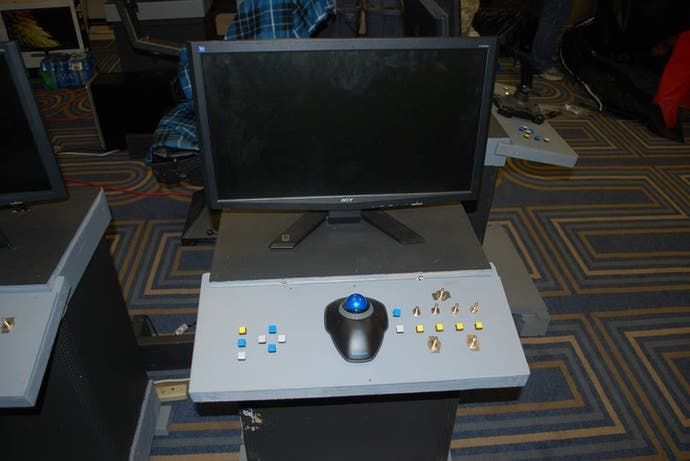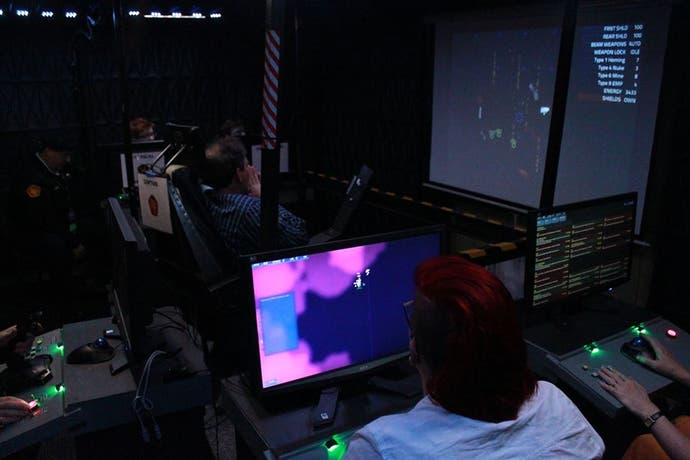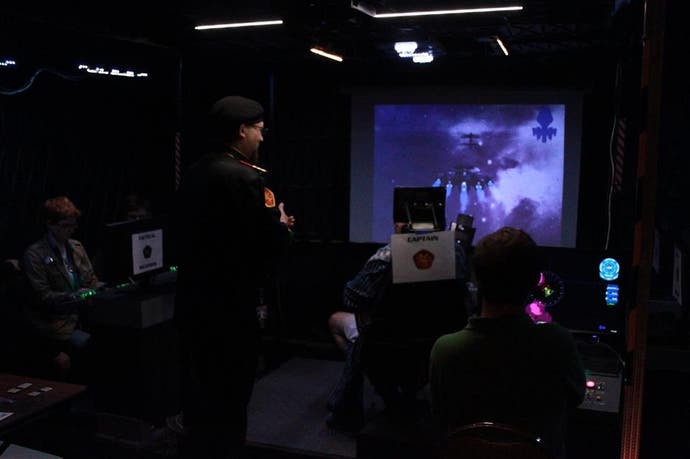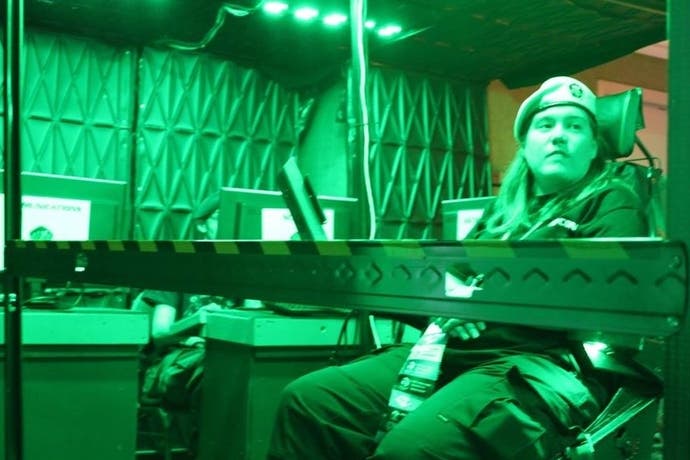An afternoon with the ultimate Star Trek simulator
Making it so.
"To boldly go where no man has gone before."
Almost 50 years later, those words still carry the weight of the human condition: to learn, to explore, to grow - verbs that describe our goals as a species. They're universal; they define what it means to be human. When it launched in 1966, Star Trek struck a delicate balance between the socially progressive and the technologically visionary. It showed us our true potential, a near-ideal future where all of humanity was united in the altruistic pursuit of art, science, peace and culture.
That the show birthed a vibrant and vocal following is no surprise. Yet in all those years, amidst all that fandom, it's taken years for a game to truly approximate the experience of being in command of a starship in Gene Roddenberry's world. Until Artemis, that is.
Conceived as a direct simulation of being on the bridge of a Star Trek ship, Artemis requires a more elaborate set-up than just about any other game to play. In true Star Trek fashion, there are several stations, with someone managing each.
Weapons, engineering, science and communication all demand someone at their command - plus an optional and very much encouraged slot for a captain to oversee them all. Each player has different roles, different purposes, and all must interact with one another to effectively find, assess, and ultimately address complex, multi-faceted problems. To manage the chaos, each team member needs their own networked computer running the game. That sounds like a tall order for all but the most dedicated PC gamers, but some fans have taken the game much, much further with some truly impressive results.

In my home city of Minneapolis, one group built their own fully customized bridge. I stumbled across their booth, decked out in green ambient lighting, some months ago at a local science fiction convention. Part of the much larger live-action role playing group, the Royal Manticore Navy, they called their craft the HMS Artemis and filled out their division with real-life military of every type. Many had done service in the US Army or the Air Force, and a good chunk of their build was cobbled together from armed forces surplus equipment. All told it cost thousands of pounds and countless man-hours. It was well worth the effort though.
About a month after our initial meeting, the group invited me to play with them in the basement of one of their team members. Their bridge was semi-portable, taking a few hours to take down and a good few more to put back together again. Running on a half-dozen donated computers, a couple of network switches and an intimidating tangle of errant wires, the lights flickered on and the room came to life after we spent the better part of the afternoon fiddling with the ship's innards.
Once those switches had been flicked, I felt like I'd stepped onto the bridge of the Millennium Falcon - an iconic and powerful machine that also relied on some on some slapdash engineering to too keep operational. I was in a space and an ambience the likes of which I'd never seen, and I could see how Gene Roddenbury's vision was alive and well in this suburban basement.
I started out on the weapons console, my shipmates telling me it was one of the easier jobs to learn. I flicked a few switches, pressed some buttons to familiarise myself with the basic controls, which, again, were made by hand by the team to better represent the feel of each station from Star Trek. The console had a heft to it that appropriately matched the burden of the gunner, with a few clunky, additional buttons to arm different weapon types, switch between different kinds of torpedo tubes and raise or lower the shields.

It was a lot to keep track of, but it felt surprisingly natural. Artemis' lead designer, Thomas Roberts said in an interview a few years back that one of his goals with the project was to make sure that watching classic science fiction felt almost like a tutorial for the game. Armed with all I'd absorbed from years of Star Trek, Battlestar Galactica, and Stargate I knew I should lead with weapons that can disrupt shields, and hit enemy ships when they were defenceless. Perhaps more importantly, I was already familiar with the typical visual shorthand for all of these ideas. Pulling from all of these shows, Artemis felt like a natural extension of all that I had learned - especially with the fan-made controls.
When the time came, I was a natural. We'd warp in, right next to our target, I'd launch a few volleys, start up the shields then finish with a nuclear weapon or two. After a few waves of failed assaults, the mercenaries took to assaulting civilians - and that's when the team got serious. Space monsters, horrible abominations known for being essentially invulnerable and absolutely ruthless, became our targets. We'd harass them a bit to get them to chase us before leading them straight to enemy strong holds and warping out. Precise shield control was absolutely vital - too much and we'd use up all our power; too little and we'd be torn to shreds in a matter of seconds. After an hour of careful planning, precise manoeuvring, excellent leadership, and perfect communication we'd cleared the mission.
For our next game, the team had me on engineering - a station more about making sure everyone else had the right amount of power at the right time and none of the components were overheating. Engineers had two main resources to manage - power and coolant. Both could be sapped by enemy weapons, and it was rare to have all systems capable of safely operating at maximum capacity all the time. Once again, the custom controls and years of being a sci-fi fan made it easy to adapt to the new station. After another hour we'd cleared one of the hardest missions currently available. We continued like this for a bit so that I could get some level of experience with each of the ships' systems, and familiarize myself with the majority of the basic tactics a successful crew needed.
We played into the night, until the team was comfortable letting me take the captain's chair. The seat was fashioned from some scrap that had seen actual combat in some war (though which one I'm not sure). The station was intimidating - built from intentionally aggressive, military-grade hardware. Even so, it was curiously comfortable. The privilege of sitting there was its own reward, an innate acknowledgement of the stresses of the position. Stresses that, despite my practice, I clearly wasn't ready for.
We stepped the difficulty down a bit and took things pretty slowly at first - though it was soon clear I had no idea what was doing. The beauty of Artemis is that its complexity is presented in stages - accessible to those who can understand and follow orders without question, but difficult for the ones that that need to think on the fly.

Superficially, the game is simple. Most of the tactics are similar, you'll rely on the same kinds of tricks again and again. The difficulty comes from the big picture - how you marshal the resources of ships and starbases around you, and how well you can keep everyone on your team working together and communicating effectively. At its most fundamental level, that's really what Artemis is about - communication. Cross-talk between the weapons and engineering or between the captain and the help keep the ship running well, and when those lines break down, it can all fall apart disturbingly fast.
I, not yet familiar with how to shout out command headings, told our helmsman to veer a bit too close to a black hole. We survived, but to do so we had to push our engines to their limits, nearly overheating the system and burning through an insane amount of power in the process. After that, we simply couldn't handle wave after wave of enemy ship. We tried a few clever strategies, but nothing quick made up for our resource deficit.
Failing your first time in the captain's seat is normal, I'm told. It's a learning process, a rite of passage, like Star Trek's Kobayashi Maru. Afterwards, I saw them run through the same mission with a more experienced captain without any problems, before we retired and finished off a box of pizza together. We chatted a bit, and I came to learn a bit about each of the people in this group. They weren't anything like I expected. These people had diverse backgrounds, and plenty of disparate interests, and they just happened to share this one game and a love of the Honorverse, a military science fiction universe by David Weber. Together, they told me, they'd found amazing friends, dedicated themselves to charity, community service, and acts of kindness.
These people, while not necessarily fans of Star Trek, were all linked to this utopian vision of the future. And while they spent a lot of time and money making a very expensive play set for what some might call a silly game, the reality of it is much more beautiful. These people were living the future they wanted to see.
Chris, the active-duty military service member, is preparing to leave his home and his family as he goes on tour once again. Faced with the inherent uncertainty and tension that service brings, he knows he's got a supportive community of friends that await his return.

